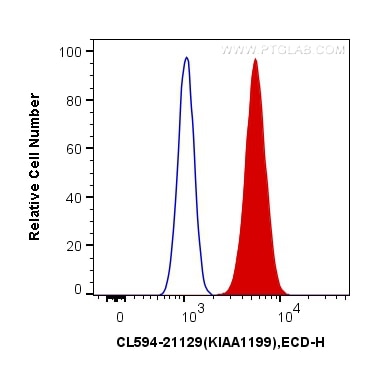- Featured Product
- KD/KO Validated
KIAA1199 / CEMIP Polyklonaler Antikörper
KIAA1199 / CEMIP Polyklonal Antikörper für FC (Intra)
Wirt / Isotyp
Kaninchen / IgG
Getestete Reaktivität
human, Maus, Ratte
Anwendung
FC (Intra)
Konjugation
CoraLite®594 Fluorescent Dye
Kat-Nr. : CL594-21129
Synonyme
Geprüfte Anwendungen
| Erfolgreiche Detektion in FC (Intra) | HepG2-Zellen |
Empfohlene Verdünnung
| Anwendung | Verdünnung |
|---|---|
| Durchflusszytometrie (FC) (INTRA) | FC (INTRA) : 0.40 ug per 10^6 cells in a 100 µl suspension |
| It is recommended that this reagent should be titrated in each testing system to obtain optimal results. | |
| Sample-dependent, check data in validation data gallery | |
Produktinformation
CL594-21129 bindet in FC (Intra) KIAA1199 / CEMIP und zeigt Reaktivität mit human, Maus, Ratten
| Getestete Reaktivität | human, Maus, Ratte |
| Wirt / Isotyp | Kaninchen / IgG |
| Klonalität | Polyklonal |
| Typ | Antikörper |
| Immunogen | KIAA1199 / CEMIP fusion protein Ag15527 |
| Vollständiger Name | KIAA1199 / CEMIP |
| Berechnetes Molekulargewicht | 1361 aa, 153 kDa |
| Beobachtetes Molekulargewicht | 150 kDa |
| GenBank-Zugangsnummer | BC020256 |
| Gene symbol | KIAA1199 |
| Gene ID (NCBI) | 57214 |
| Konjugation | CoraLite®594 Fluorescent Dye |
| Excitation/Emission maxima wavelengths | 588 nm / 604 nm |
| Form | Liquid |
| Reinigungsmethode | Antigen-Affinitätsreinigung |
| Lagerungspuffer | PBS with 50% glycerol, 0.05% Proclin300, 0.5% BSA |
| Lagerungsbedingungen | Bei -20°C lagern. Vor Licht schützen. Nach dem Versand ein Jahr stabil. Aliquotieren ist bei -20oC Lagerung nicht notwendig. 20ul Größen enthalten 0,1% BSA. |
Hintergrundinformationen
KIAA1199, also known as CEMIP, was first discovered as an inner-ear protein with genetic mutations linked to nonsyndromic hearing loss. KIAA1199 is involved in hyaluronan degradation. Studies have shown that KIAA1199 is overexpressed in many types of cancers, suggesting a critical role of KIAA1199 in cancer progression.
Protokolle
| PRODUKTSPEZIFISCHE PROTOKOLLE | |
|---|---|
| FC protocol for CL594 KIAA1199 / CEMIP antibody CL594-21129 | Download protocol |
| STANDARD-PROTOKOLLE | |
|---|---|
| Klicken Sie hier, um unsere Standardprotokolle anzuzeigen |


